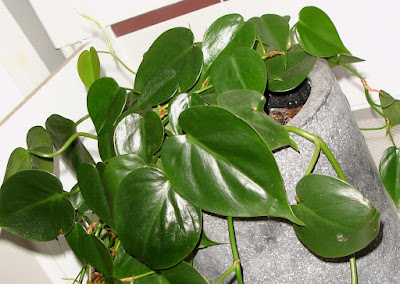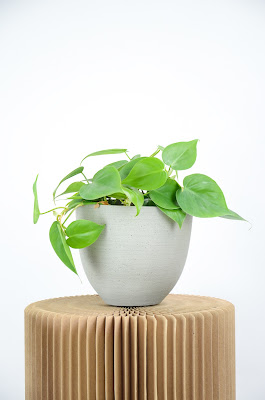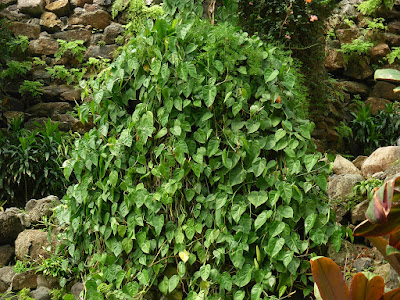Philodendron scandens - Velvet Leaf Philodendron is a colorful and attractive evergreen climber with dark green older leaves and red young leaves...
Philodendron scandens also called as Velvet Leaf Philodendron, Philodendron acrocardium, Philodendron cuspidatum, Philodendron harlowii, Philodendron isertianum, Philodendron micans, Philodendron micans var. brevipes, Philodendron micans var. microphyllum, Philodendron microphyllum, Philodendron miduhoi, Philodendron oxyprorum, Philodendron pittieri, Philodendron prieurianum, Philodendron scaberulum, Philodendron scandens subsp. cubense, Philodendron scandens var. cubense, Philodendron scandens var. cuspidatum, Philodendron scandens subsp. isertianum, Philodendron scandens f. micans, Philodendron scandens subsp. prieurianum, Philodendron subsessile, and its scientific name Philodendron hederaceum var. hederaceum, is a variety of Philodendron hederaceum in the genus Philodendron. This variety was described by Heinrich Wilhelm Schott in 1829.
DESCRIPTION OF PHILODENDRON SCANDENS - VELVET LEAF PHILODENDRON CARE
Philodendron scandens is native to Mexico to Tropical America. It is found growing principally in tropical moist forest but ranges into premontane wet forest and even tropical wet forest, ranging from San Luis Potosí State in Mexico to the Greater and Lesser Antilles, and down both slopes of the Andes, east to the Guianas and south to Brazil and Bolivia. In Central America, the variety occurs on both slopes of the Continental Divide.
It is an evergreen hemiepiphyte climbing vine which reaching 4 meters long with thick, round, fleshy and flexible stems with trailing growth habit. The leaves are 11-50 cm long, 8-34 cm wide, shiny, waxy, heart-shaped with thin, curved tips; upper surface medium to dark green, velvety when juvenile, drying brown to greenish brown, lower surface medium green, glossy, drying gray-green to yellow-green. The leaves are held on the 6-33 cm long, green petioles.
Velvet Leaf Philodendron blooms blooms when the plants are mature from the single, erect or hanging inflorescences that are formed by the 9-20 cm long, usually green, sometimes yellowish white spathe and 12-18 cm long spadix that are held on 2-16 cm long peduncle. All parts of plant contain calcium oxalate crystals, an irritant to the mouth and esophagus.
PHILODENDRON SCANDENS - VELVET LEAF PHILODENDRON CARE AND CULTURE
Cultural information should only be used as a guide, and should be to be adapted to suit you. Your physical location; where you grow your plants, how much time you have to devote to their care, and many other factors, will need to be taken into account. Only then can you decide on the cultural methods that best suit you and your plants.
Light:
Philodendron scandens grows best in bright and indirect sunlight. Exposure to the sunlight can causes a yellowish color in the leaves or a sunburn spot. Too little light can result in leggy growth with lots of space in between the leaves. Artificial light gives best results if natural light is not present. Young plants can be grown in a hanging basket, with the stems trailing down. As they grow larger, attach the stems to a pole or trellis to keep it compact in small space.
Rotate your plant periodically to ensure even growth on all sides and dust the leaves often so the plant can photosynthesize efficiently. When dusting the leaves, also take the opportunity to inspect the undersides and keep an eye out for pests.
Temperature:
Velvet Leaf Philodendron grows well in normal to warm indoor temperatures 24-27ºC (75-80ºF). They cannot tolerate temperatures which drop below about 13ºC (55ºF). In mild, frost-free climates, the plant can be grown outside in shady spots. If grown outside, night temperatures down to around 15°C and day temperatures around 30°C are ideal.
Substrate and growing media:
Philodendron scandens grows best in loose, well-drained soil which is rich high in organic matter. It also be grow in 100% sphagnum peat moss and mixtures such as peat-vermiculite or peat-perlite.
The plants benefit from repotting to a larger container when they become root bound and outgrow the original pot. A combination of half soil-based potting mixture and half leaf mould or coarse peat moss is used.
Move the plant into container one size larger only when their roots have completely filed the current one. This is done at any time of year except during the short rest period. After the long rest period the convenient pot size has been reach (probably about 25-30cm (10-12 inch)), an annual spring top-dressing with fresh potting mixture will help to keep the plat healthy. A container with drainage holes to prevent root rot is used. A cachepot is used if a decorative container is without drainage. It is necessary to cover the bottom of a cachepot with pebbles so as to keep the plant above the drainage water.
Watering:
Fertilizer:
Philodendron scandens are considered heavy feeders. Regular feeding program with a nitrogen fertilizer will increase leaf size and produces a larger, healthier plant. Throughout the months while the plant is actively growing (from spring until fall) apply standard liquid fertiliser once every two weeks. It's a nice strategy to fertilize more frequently at half strength than to apply one strong dose. Plants which mainly grows in low-light conditions require less fertilization than actively-growing plants. Moist soil requires fertilizers to avoid injury to plant roots.
Pruning:
Use a sharp pruners or scissors to control the size and shape of the plant. This trailing plant can get quite long, but it can be kept bushy by trimming some of the stems back to the soil line. New shoots will emerge. Always wear gloves when pruning and wash your hands and tools when finished. You don't want to get the sap in your eyes or mouth.
Pests and diseases:
No serious insect or disease problems is however reported. Watch for aphids, spider mites, mealy bugs and scale. Leaf spots may occur. Root rot can occur in overly moist soils. Small leaves or long spaces between leaves show that the plant need enough light to grow.
Propagation:
Cutting and layering are popular methods of Philodendron species propagation. Try propagating them during the growing season. A small brown nubs are formed where the leaves meet the stem. These nubs, when in contact with soil or water, will grow roots. There are many ways to propagate this plant, the easiest being to cut a branch just below a root-nub and place it in water with a few pieces of horticultural charcoal to reduce the likelihood of rot. As soon the growth of new leaf takes place it is potted in the rich soil. Similarly it can also be propagated within its own pot by pinning vines at the root-nub to the soil with hairpins or bent wire. The root nub in contact with the soil will sprout new roots in a very short time. When the different parts of Philodendron species are rooted, the plant will greatly profited from misting several times a day.
BUY PHILODENDRON SCANDENS - VELVET LEAF PHILODENDRON AND RELATED PRODUCTS
BUY ANOTHERS SPECIES AND VARIETIES OF PHILODENDRON GENUS HERE!















COMMENTS